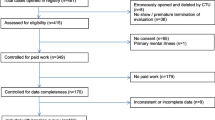Abstract
Pain-related work disability can be influenced by a number of medical, physical, and psychosocial factors. The present study investigated the role of perceived disability, occupational stress, pain, and distress in patients with chronic pain disorders who work despite pain and patients who are work disabled. A total of 165 patients referred to a multidisciplinary pain treatment center for chronic pain (> 6 months) were studied. The two groups were compared on age, gender, education, marital status, duration of pain problem, pain severity, psychological distress, perceived disability, and perception of the work environment. A discriminant function analysis was computed entering pain severity, distress, perceived disability (physical and psychosocial) and work environment variables. The two groups were equivalent on age, gender, education, marital status, and duration of pain problem. The groups differed on diagnosis and insurance coverage with the work-disabled group diagnosed with low back pain and receiving Workers Compensation coverage more frequently than working controls. Univariate analyses indicated that the work-disabled group reported higher pain severity, perceived physical and psychosocial disability, and job stress than their working cohorts. The discriminant function analysis indicated that the perception of physical disability, supervisor support, distress, and work pressure were capable of correctly classifying patients with chronic pain who continued to work from those who were work disabled. These findings indicate the importance of evaluating perceived disability and job stress, and if present, directing intervention effort at these factors in order to facilitate work re-entry.
Similar content being viewed by others
References
Feuerstein M. A multidisciplinary approach to the prevention, evaluation and management of work disability.J Occup Rehab 1991; 1: 5–12.
McGill GM. Industrial back problems: A control program.J Occup Med 1968; 10: 174–178.
Snook SH. The costs of back pain in industry.Spine: State of the Art Reviews 1987; 2: 1–5.
Webster BS, Snook SH. The cost of compensable low back pain.J Occup Med 1990; 32: 13–15.
Bandura A. Self-efficacy: Toward a unifying theory of behavioral change.Psychol Bull 1977; 80: 286–303.
Dolce JJ. Self-efficacy and disability beliefs in behavioral treatment of pain.Behav Res Ther 1987; 25: 289–299.
Hirsch G, Beach G, Cooke C, et al. Relationship between performance on lumbar dynamometry and Waddell score in a population with low back pain.Spine 1991; 16: 1039–1043.
Sandstrom J, Esbjornsson E. Return to work after rehabilitation: The significance of the patient's own prediction.Scand J Rehab Med 1986; 18: 29–33.
Bigos SJ, Battie MC, Spengler DM, et al. A prospective study of work perceptions and psychosocial factors affecting the report of back injury.Spine 1991; 16: 1–6.
Svensson HO, Andersson GBJ. Low back pain in 40 to 47-year-old men: Work history and work environment factors.Spine 1983;8: 272–276.
Feuerstein M, Sult S, Houle M. Environmental stressors and chronic low back pain: Life events, family and work environment.Pain 1985; 22: 295–307.
Feuerstein M, Papciak AS.University of Rochester Pain questionnaire. 1983.
Melzack R. The McGill Pain Questionnaire: Major properties and scoring methods.Pain 1975; 1: 277–299.
Bergner M, Bobitt RA, Carter WB, Gilson BS. The sickness impact profile: Development and final revision of a health status measure.Med Care 1981; 19: 787–805.
Moos RH.Work environment scale manual. Palo Alto, CA: Consulting Psychologists Press, 1981.
Overall JH, Gomez-Mont F. The MMPI-168 for psychiatric screening.J Educat Psychol Measure 1974; 34: 315–319.
Turk DC, Rudy TE. Persistent pain and the injured worker: Integrating biomedical, psychosocial, and behavioral factors in assessment.J Occup Rehab 1991; 1: 159–179.
Weisel SW, Tsourmas N, Feffer H, et al. A study of computer-assisted tomography. 1. The incidence of positive CAT scans in an asymptomatic group of patients.Spine 1984; 9: 549–551.
Waddell G. A new clinical model for the treatment of low back pain.Spine 1987; 12: 632–644.
Flor H, Turk DC. Chronic back pain and rheumatoid arthritis: Predicting pain and disability from cognitive variables. J Behav Med 1988; 11: 251–265.
Jensen MP, Turner JA, Romano JM, Karoly P. Coping with chronic pain: A critical review of the literature.Pain 1991; 47: 249–283.
Armstrong TJ. Ergonomics and cumulative trauma disorder.Hand Clin 1986; 2: 553–565.
Chaffin DB, Andersson GBJ.Occupational biomechanics (2nd Ed.). Philadelphia, PA: Wiley Interscience, 1991.
Feuerstein M, Hickey PF. Ergonomic approaches in the clinical assessment of occupational musculoskeletal disorders. In Turk DC, Melzack R, eds.,Handbook of pain assessment. New York: Guilford Press (in press).
Feuerstein M, Labbe EE, Kuczmierczyk AR.Health psychology: A psychobiological perspective. New York: Plenum, 1986.
Isreal BA, House JS, Schurman SJ, et al. The relationship of personal resources, participation, influence, interpersonal relationships, and coping strategies to occupational stress, job strains, and health: A multivariate analysis.Work Stress 1989; 3: 163–194.
Author information
Authors and Affiliations
Rights and permissions
About this article
Cite this article
Feuerstein, M., Thebarge, R.W. Perceptions of disability and occupational stress as discriminators of work disability in patients with chronic pain. J Occup Rehab 1, 185–195 (1991). https://doi.org/10.1007/BF01073455
Issue Date:
DOI: https://doi.org/10.1007/BF01073455




